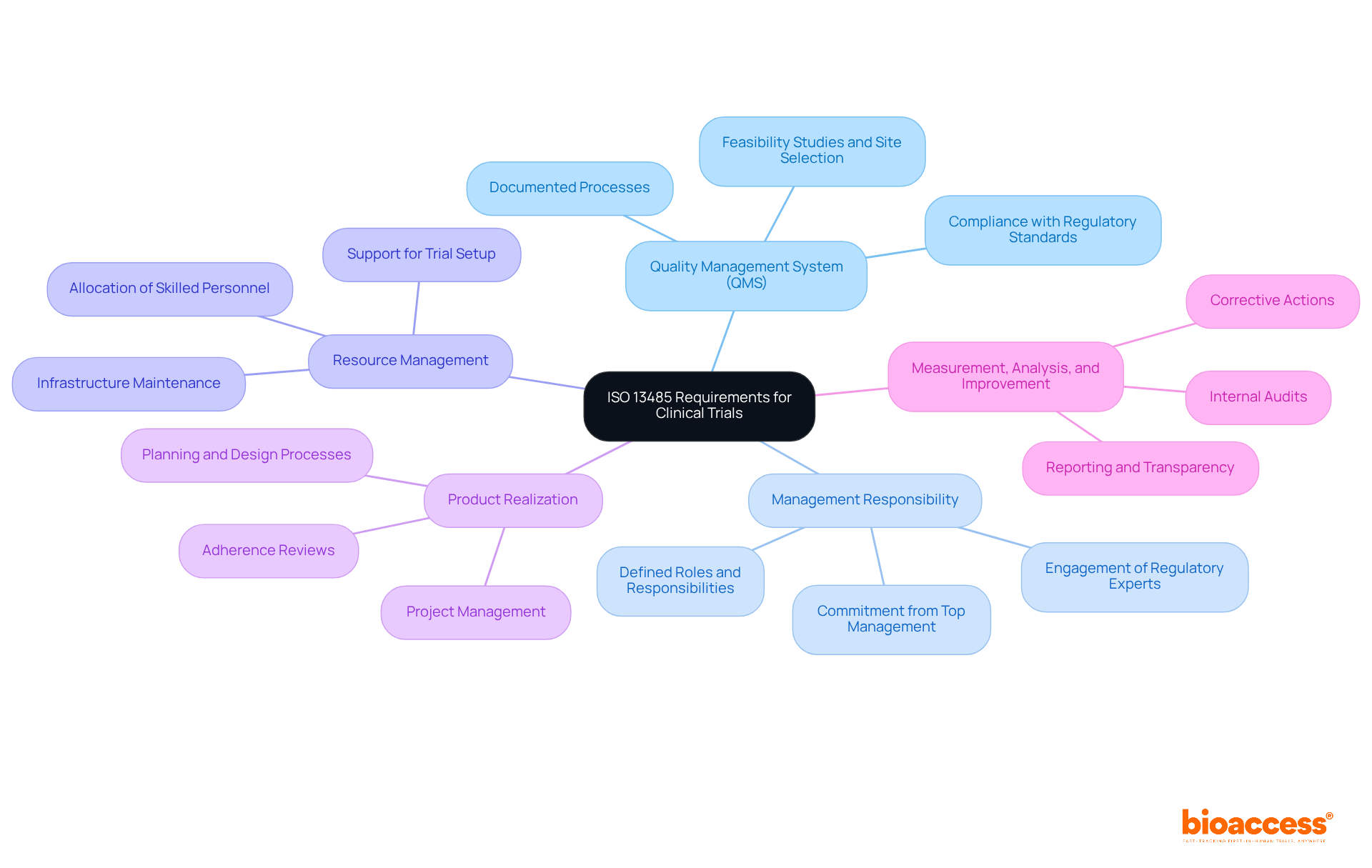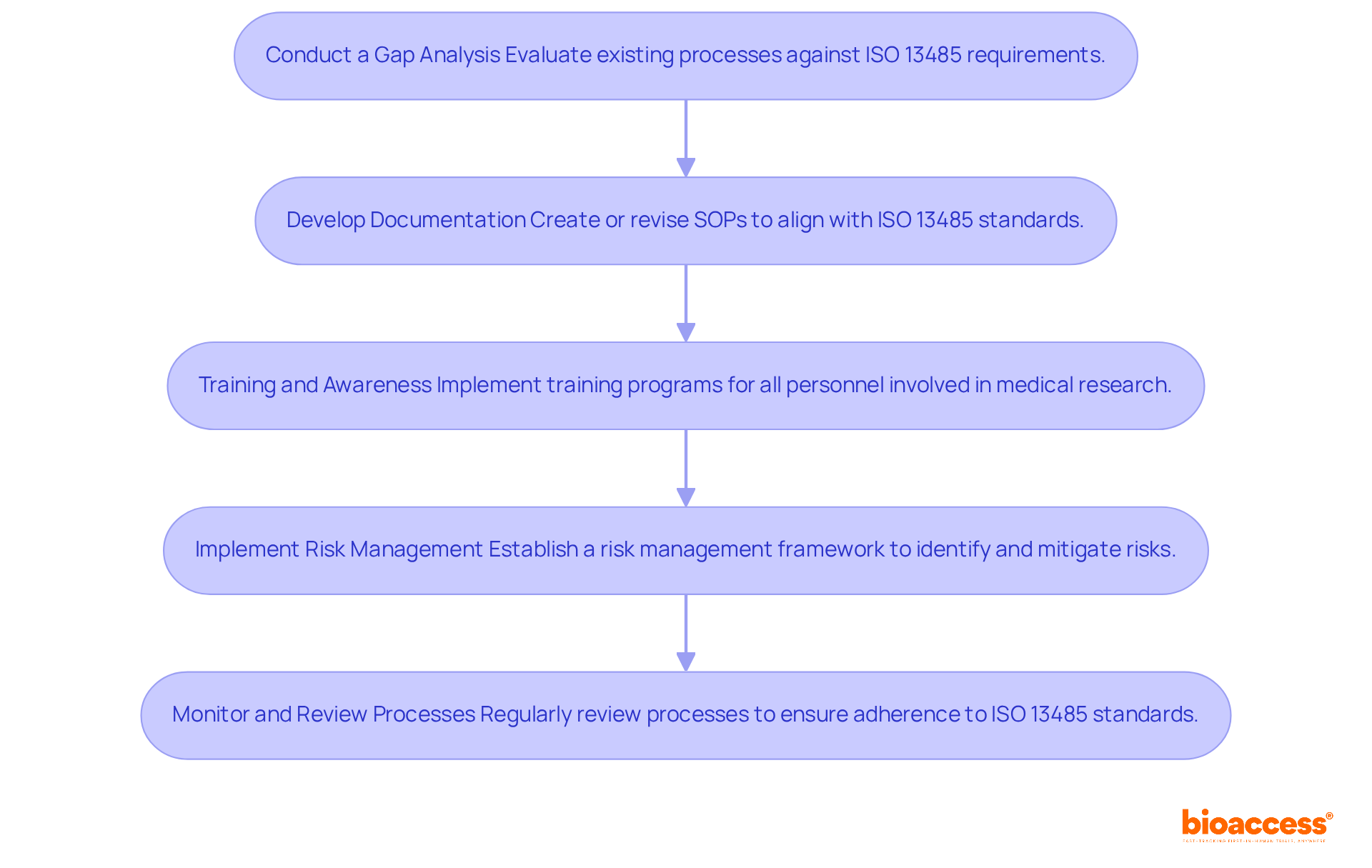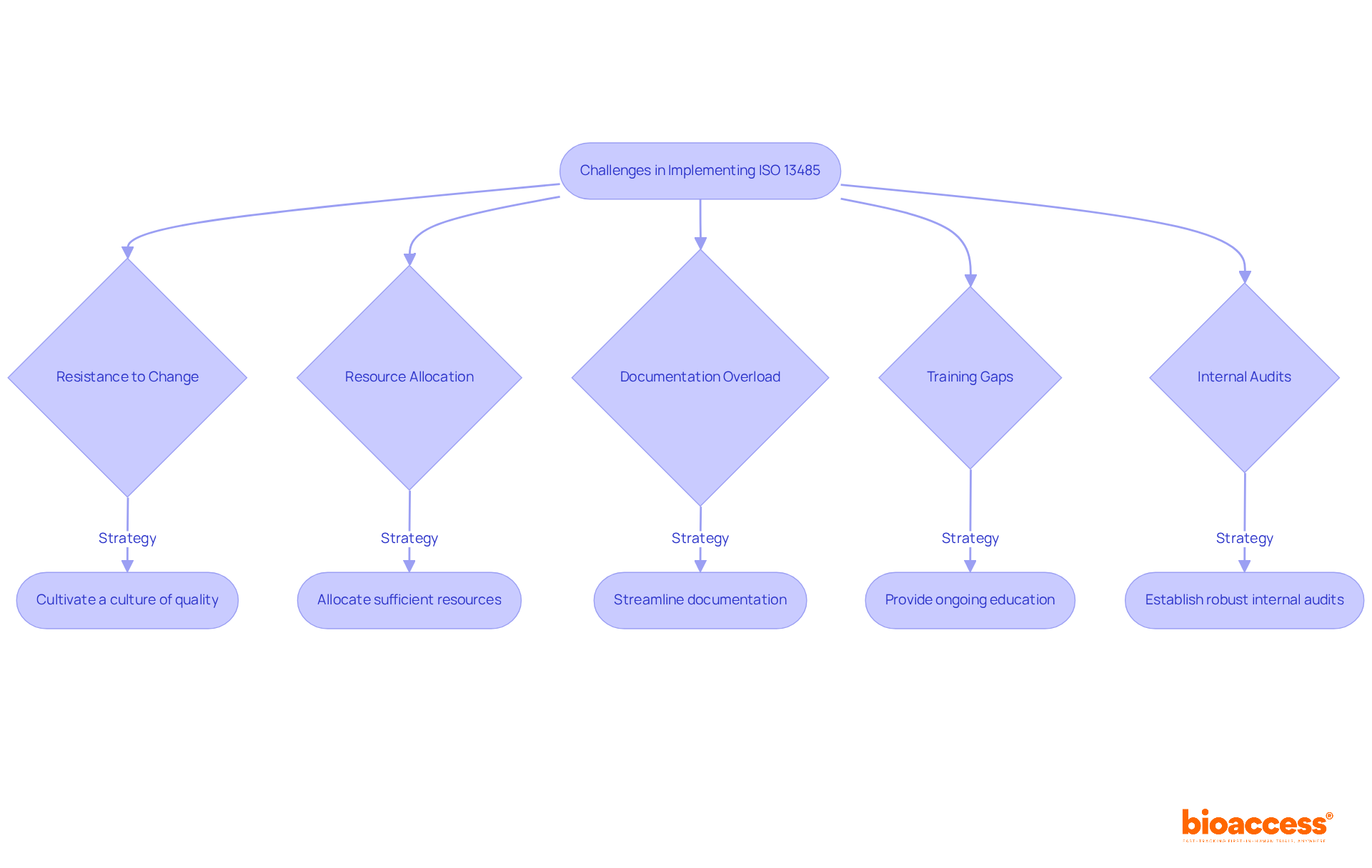


Mastering the latest version of ISO 13485 is essential for success in clinical research, particularly when it comes to ensuring quality management and compliance in the medical device sector. This standard significantly enhances risk management, credibility, and continuous improvement, which are vital for achieving better data integrity and patient outcomes in clinical trials.
In the ever-evolving Medtech landscape, ISO 13485 serves as a cornerstone for organizations striving to meet regulatory requirements and improve their operational processes. By adopting this standard, companies can effectively address key challenges, ensuring that their products not only meet safety and efficacy standards but also foster trust among stakeholders.
Collaboration is crucial in this context. As organizations work together to implement ISO 13485, they can share insights and best practices, ultimately leading to a more robust clinical research environment. The next steps involve:
ISO 13485 stands as a cornerstone for quality management in the medical device industry, ensuring that products not only meet regulatory requirements but also prioritize patient safety. In an era where clinical research is rapidly evolving, especially in regions like Latin America, grasping the latest version of this standard is essential for organizations looking to enhance the integrity of their trials and improve health outcomes.
Yet, the journey toward successful ISO 13485 implementation is not without its challenges. From resistance to change to the complexities of effective resource allocation, organizations must navigate these hurdles.
How can they effectively leverage the benefits of ISO 13485 in their clinical research efforts?
ISO stands as a globally recognized standard that delineates the criteria for a quality management system (QMS) tailored for the medical device sector. Its emphasis on consistent design, development, production, and delivery ensures that medical devices align with both customer and regulatory expectations. In the context of medical research, particularly in Latin America, adherence to ISO standards is essential for standardizing trial procedures, safeguarding the integrity of collected data, and ensuring participant safety. This is where bioaccess® shines, offering comprehensive trial management services that include feasibility studies, site selection, compliance reviews, trial setup, import permits, project management, and reporting, specifically for Early-Feasibility Studies (EFS), First-In-Human Studies (FIH), Pilot Studies, Pivotal Studies, and Post-Market Follow-Up Studies (PMCF).
Key aspects of ISO 13485 include:
Practical examples illustrate the impact of ISO on trial quality. Organizations that have integrated ISO standards into their processes report improved data integrity and compliance, leading to more successful regulatory submissions. Furthermore, the focus on statistical methods within ISO standards ensures that decisions are based on reliable data rather than conjecture, thereby enhancing the overall quality of trials.
In conclusion, understanding and implementing the ISO 13485 latest version is a critical step toward establishing effective quality management practices that can significantly improve health outcomes, particularly in the realm of expedited medical device research overseen by bioaccess®.

Implementing the ISO 13485 latest version effectively in research trials requires a solid grasp of its key requirements, which are vital for establishing a robust Quality Management System (QMS). These requirements include:
Quality Management System (QMS): Develop a comprehensive, documented QMS that outlines the necessary processes and procedures for compliance, ensuring that all aspects of clinical research are covered. This encompasses bioaccess's services in feasibility studies and site selection, which are critical for meeting regulatory standards.
Management Responsibility: Top management must show commitment to the QMS, with clearly defined roles and responsibilities to promote accountability and leadership in quality initiatives. Engaging experts like Katherine Ruiz, who specializes in regulatory affairs for medical devices in Colombia, can significantly enhance this commitment.
Resource Management: Adequate resources, including skilled personnel, must be allocated to support the QMS, ensuring that staff are equipped to maintain quality standards. This is especially crucial for navigating the complexities of trial setup and securing necessary import permits, services provided by bioaccess.
Product Realization: Establish clear processes for product realization, covering planning, design, and development phases to ensure that medical devices meet specified requirements and regulatory standards. This includes thorough adherence reviews and project management, which are integral to bioaccess's offerings.
Measurement, Analysis, and Improvement: Implement systematic processes for monitoring and measuring the QMS's effectiveness, including regular internal audits and corrective actions to foster continuous improvement. Reporting on study status, inventory, and adverse events is essential for maintaining transparency and trust in the research process, aligning with bioaccess's commitment to comprehensive project management.
Focusing on the ISO 13485 latest version requirements not only supports compliance but also enhances the overall quality of trials, ultimately leading to improved patient outcomes and increased confidence in the research process.

Integrating ISO 13485 into your clinical research processes demands a systematic approach that encompasses several essential steps:
Conduct a Gap Analysis: Start by evaluating your existing processes against ISO 13485 requirements. This crucial step helps pinpoint areas needing enhancement, serving as a foundation for adherence. Document both adherence and non-adherence areas to effectively guide your implementation strategy.
Develop Documentation: Next, create or revise standard operating procedures (SOPs) to align with ISO 13485 standards. Ensure these documents are clear, comprehensive, and easily accessible to all team members, facilitating a smooth transition to meeting the ISO 13485 latest version requirements. Additionally, develop an implementation plan that includes quantifiable objectives, deadlines, and methods for controlling processes.
Training and Awareness: Implement training programs for all personnel involved in medical research. This training should focus on the ISO 13485 latest version standards and clarify each person's role in maintaining compliance with regulations. Early communication about the changes and the benefits of the new system is crucial for gaining employee buy-in and fostering a culture of quality within the organization.
Implement Risk Management: Establish a robust risk management framework that identifies, assesses, and mitigates risks associated with clinical trials. This proactive approach should include a systematic process for risk assessment, broken into stages such as identification, root cause analysis, likelihood and impact evaluation, and tolerance thresholds. This structured approach is critical for ensuring that potential issues are addressed before they impact study outcomes.
Monitor and review your processes regularly to ensure continual adherence to the ISO 13485 latest version standards. Utilize feedback from audits and team input to make necessary adjustments, ensuring that your quality management system remains effective and responsive to evolving needs. Perform internal audits and management evaluations prior to third-party assessments for certification to sustain adherence effectively.
By diligently following these steps, organizations can successfully incorporate ISO standards into their research processes, enhancing both quality and adherence. Additionally, leveraging comprehensive clinical trial management services—such as feasibility studies, site selection, compliance reviews, trial setup, import permits, project management, and reporting—can significantly contribute to the success of clinical trials.

Implementing ISO 13485 presents several challenges, yet with effective strategies, organizations can navigate these hurdles successfully:
Resistance to Change: Cultivating a culture of quality is essential. Engage all parties in the execution process and clearly convey the advantages of ISO to encourage support and minimize opposition. As Robert Conklin noted, "Resistance is thought transformed into feeling. Change the thought that creates the resistance, and there is no more resistance."
Resource Allocation: Allocate sufficient resources, including time and personnel, to the implementation process. This helps prevent burnout and inefficiencies that can arise from inadequate support. The difficulties encountered by medical device producers frequently stem from inadequate resource distribution, as emphasized in the case study on ISO implementation.
Documentation Overload: Streamline documentation by focusing on essential records that demonstrate adherence. This approach minimizes unnecessary bureaucracy while ensuring that critical information is captured. Comprehensive documentation is a significant challenge in ISO standards adherence, and addressing this can facilitate the implementation process.
Training Gaps: Regularly assess training needs and provide ongoing education to ensure that all staff are well-equipped to meet ISO 13485 requirements. Continuous training is vital for upholding standards and enhancing overall quality.
Internal Audits: Establish a robust internal audit process to identify non-conformities early. Timely corrective measures can greatly enhance adherence and operational effectiveness.
By proactively addressing these challenges, organizations can pave a smoother path to compliance with the ISO 13485 latest version, ultimately enhancing the quality and reliability of their clinical research efforts. It's crucial to recognize that about 70% of all change initiatives fail, underscoring the necessity of implementing these strategies effectively.

Mastering the latest version of ISO 13485 is essential for success in clinical research, especially in the medical device sector. This standard establishes a robust framework for a Quality Management System (QMS) and underscores the critical roles of risk management, continuous improvement, and credibility in research findings. By aligning with ISO 13485, organizations can significantly enhance their operational effectiveness, ensuring that their clinical trials meet both regulatory and customer expectations.
The article highlights several key aspects of ISO 13485, such as:
Practical steps for integrating ISO 13485 into clinical research processes—like conducting gap analyses and implementing training programs—are vital for overcoming common challenges, including:
These strategies not only facilitate compliance but also lead to improved patient outcomes and increased trust in research findings.
Ultimately, embracing ISO 13485 transcends mere regulatory compliance; it represents a commitment to quality and excellence in clinical research. Organizations are urged to take proactive steps in their implementation efforts, recognizing the substantial benefits that adherence to these standards brings. By doing so, they position themselves for success in the ever-evolving landscape of medical technology and clinical trials, ensuring that their research positively impacts health outcomes and regulatory advancements.
What is ISO 13485 and why is it important in clinical research?
ISO 13485 is a globally recognized standard that specifies the criteria for a quality management system (QMS) specifically for the medical device sector. Its importance in clinical research lies in ensuring that medical devices meet customer and regulatory expectations, standardizing trial procedures, safeguarding data integrity, and ensuring participant safety.
How does ISO 13485 contribute to risk management in clinical trials?
ISO 13485 emphasizes a systematic approach to quality management, which is essential for identifying and mitigating risks associated with clinical trials, thereby enhancing the safety and reliability of the research process.
What benefits does compliance with ISO 13485 provide to research findings?
Compliance with ISO 13485 enhances the credibility of research findings, making them more acceptable to regulatory bodies that increasingly require data-driven evidence for approval.
How does ISO 13485 promote continuous improvement in organizations?
The standard fosters a culture of continuous improvement, which is crucial in the rapidly evolving medical technology landscape. Organizations that embrace this culture are better equipped to adapt to changes and improve operational efficiency.
Can you provide examples of how ISO 13485 impacts trial quality?
Organizations that have integrated ISO standards into their processes report improved data integrity and compliance, leading to more successful regulatory submissions. The focus on statistical methods within ISO standards ensures that decisions are based on reliable data, enhancing the overall quality of trials.
What services does bioaccess® offer in relation to ISO 13485 compliance?
Bioaccess® provides comprehensive trial management services that include feasibility studies, site selection, compliance reviews, trial setup, import permits, project management, and reporting for various types of studies, including Early-Feasibility Studies (EFS), First-In-Human Studies (FIH), Pilot Studies, Pivotal Studies, and Post-Market Follow-Up Studies (PMCF).
Why is understanding ISO 13485 crucial for medical device research?
Understanding and implementing the latest version of ISO 13485 is critical for establishing effective quality management practices that can significantly improve health outcomes, especially in expedited medical device research overseen by organizations like bioaccess®.